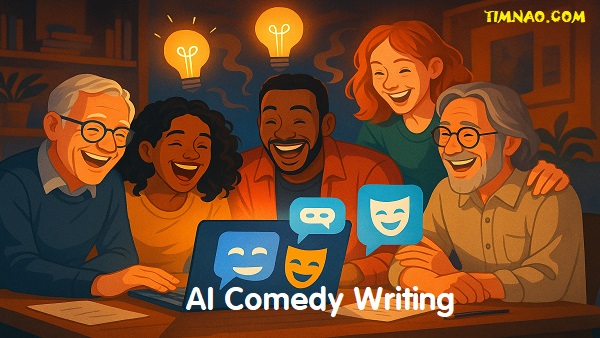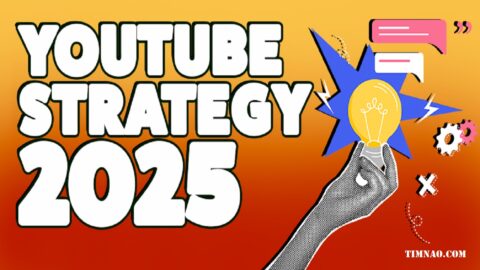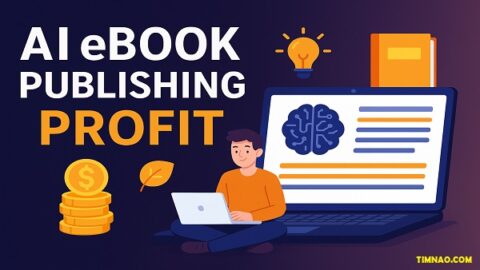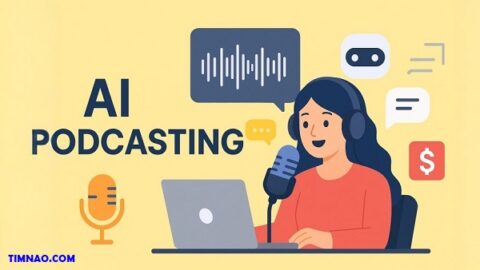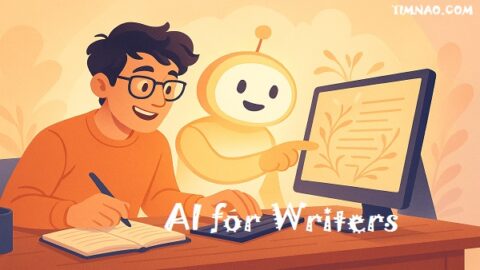Unlock Your Inner Comedian: A Beginner’s Guide to AI Comedy Writing 🤖
Ready to turn those shower thoughts and witty remarks into actual comedy gold? Ever dreamt of writing a hilarious script but felt overwhelmed by the blank page? Well, guess what? The future of funny is here, and it involves a fascinating new writing partner: Artificial Intelligence! This guide is your friendly introduction to AI comedy writing, showing you how you can team up with tools like ChatGPT to brainstorm, develop, and polish your comedic ideas, even if you’re a complete beginner.
We’ll explore how AI comedy writing isn’t about replacing your unique humor, but about supercharging it. Think of AI as your tireless brainstorming buddy, your joke-polishing assistant, and your guide through the sometimes-daunting landscape of script creation. Get ready to learn how to craft everything from snappy one-liners to full-fledged comedy scripts with a little help from your new digital collaborator. This is your ultimate resource for diving into beginner comedy AI and unleashing those laughs!
Focus Keywords: AI comedy writing, ChatGPT comedy script, beginner comedy AI
Suggested URL Slug:
SEO Title:
SEO Meta Description:
📜 Table of Contents
- 🤣 What Exactly IS AI Comedy Writing? (And Why It’s Not Cheating!)
- 💡 Getting Started: Your First Steps into Beginner Comedy AI
- 🤖 Meet Your AI Co-Writer: Leveraging Tools Like ChatGPT for Comedy
- 🎭 The Building Blocks of Funny: AI’s Role in Crafting Comedic Concepts
- 🧍 Creating Memorable Laugh-Makers: Developing Characters with AI
- ✍️ From Blank Page to Hilarious Scenes: Writing Your ChatGPT Comedy Script
- 🎤 Punching Up the Funny: Refining Jokes and Dialogue with AI
- 🎬 Beyond the First Draft: Using AI for Structure and Polishing
- 🚀 The Future is Funny: Embracing AI in Your Comedy Writing Journey
- ❓ AI Comedy Writing FAQs: Your Questions Answered!
🤣 What Exactly IS AI Comedy Writing? (And Why It’s Not Cheating!)
So, you’ve heard the buzz about AI, and maybe you’re wondering how on earth a machine can help write something as nuanced and human as comedy. That’s a great question! AI comedy writing is essentially the process of using artificial intelligence tools, like OpenAI’s ChatGPT, to assist in various stages of creating comedic content. This could be anything from brainstorming joke ideas and developing character quirks to structuring entire scenes or even generating first drafts of dialogue.
Think of it less like the AI is “writing” the comedy for you, and more like it’s an incredibly versatile assistant. It’s like having a writers’ room in your pocket, ready 24/7 to bounce ideas off, explore different angles, and help you overcome creative blocks. For anyone venturing into beginner comedy AI, this is fantastic news. The initial fear might be, “Is this cheating? Is it still my comedy?” The answer is a resounding “It’s a tool, and your creativity is still the driving force!”
The PDF document “The 24-Hour Comedy TV Show with ChatGPT” emphasizes that AI works best with you. It’s not about hitting a magic button for a finished sitcom. Instead, it’s a creative partner that can help brainstorm, punch up dialogue, shape arcs, and get you unstuck. Your unique voice, your experiences, and your sense of humor are what make your comedy special. AI simply provides new ways to explore and express that.
Recent trends in AI scriptwriting, as highlighted by various online sources, show a growing acceptance and integration of these tools in creative industries. AI can help analyze successful comedic structures, suggest alternative punchlines, or even generate dialogue in specific tones or styles. The key is that you are the director. You guide the AI, you make the final decisions, and you infuse the work with your personal comedic genius. It’s about collaboration, not replacement.
The core idea is that AI helps you “fail faster” and iterate more quickly. Instead of getting bogged down, you can generate multiple options and see what sparks joy (and laughter!). This is especially empowering for beginners who might not have a traditional writers’ room or years of experience to draw upon.
💡 Getting Started: Your First Steps into Beginner Comedy AI
Dipping your toes into the world of AI comedy writing can feel both exciting and a tad overwhelming. But don’t worry, the learning curve is gentler than you think! Here’s a simple roadmap for beginners:
1. Understand the Basics of Comedy (AI or Not!):
Before you even open an AI tool, have a think about what makes you laugh. The PDF stresses the importance of your “why” – your motivation for wanting to create comedy. Is it observational humor? Character-driven stories? Absurdist scenarios?
- Truth in Comedy: Great comedy often stems from truth – relatable human experiences, flaws, and absurdities of everyday life.
- Contrast and Surprise: Comedy often plays with expectations versus reality, creating surprise.
- Recognition: Audiences laugh when they see themselves or familiar situations reflected, even if exaggerated.
2. Choose Your AI Tool:
While there are several AI writing assistants out there, ChatGPT is a widely accessible and powerful option, particularly for its conversational abilities and creative text generation. Many online guides for beginner comedy AI also focus on its capabilities. Look for:
- User-friendliness: Is the interface intuitive?
- Flexibility: Can it handle different types of requests (dialogue, plot ideas, character sketches)?
- Customization: Can you guide its tone and style?
3. Learn Prompt Engineering (It’s Easier Than It Sounds!):
“Prompting” is simply how you ask the AI to do something. The better your prompts, the better the results.
- Be Specific: Instead of “Write a funny scene,” try “Write a funny scene for a ChatGPT comedy script where a nervous dog walker tries to explain to a skeptical cat owner why all seven of her prize-winning Persian cats are now hiding in a single oak tree.” The PDF highlights giving AI detailed character traits and situations for more specific responses.
- Set the Tone: “Write it in a lighthearted, witty tone, similar to a classic sitcom.”
- Iterate: Don’t expect perfection on the first try. Refine your prompts. Ask for variations. “Give me five different punchlines for that last joke.” Or, “Make the cat owner even more sarcastic”.
4. Start Small and Experiment:
Don’t aim to write a full feature film on day one.
- Joke Generation: Ask the AI for jokes on a specific topic or in a particular style.
- Character Brainstorming: “Give me five quirky habits for a character who is a retired pirate trying to run a successful flower shop.”
- Dialogue Snippets: “Write a short, funny exchange between two roommates arguing over who ate the last slice of pizza, where one is a drama queen and the other is extremely stoic.”
5. Embrace the “Collaborator” Mindset:
Remember, AI is your co-writer, not your replacement. Use its outputs as a starting point, a source of inspiration, or a way to see your ideas from a different angle. You are the curator, the editor, and the ultimate comedic voice. Online resources confirm that the most effective use of AI in scriptwriting involves this human-AI partnership, where the writer guides the AI’s strengths.
Getting comfortable with these initial steps will set a solid foundation for your journey into AI comedy writing. The key is to play, experiment, and see how these powerful tools can augment your natural comedic talents.
🤖 Meet Your AI Co-Writer: Leveraging Tools Like ChatGPT for Comedy
Okay, so you’re ready to team up with an AI. ChatGPT, for instance, can be an incredible asset in your AI comedy writing toolkit. But how do you actually use it effectively to create that killer ChatGPT comedy script or just to generate some fresh ideas?
1. The Brainstorming Powerhouse:
Writer’s block? ChatGPT doesn’t know the meaning of the word!
- Idea Generation: Feed it a simple premise, a “what if” scenario, or even just a random word, and ask it to generate comedy concepts. “What are some funny situations that could arise if a time traveler accidentally brought a T-Rex to a modern-day pet show?” The PDF emphasizes ChatGPT’s ability to brainstorm characters, punch up dialogue, and shape arcs.
- Exploring Subgenres: Not sure if your idea is a sitcom, a dark comedy, or a surreal sketch? Describe your concept and ask ChatGPT to explore how it might fit into different comedy subgenres. The document lists various subgenres like sitcoms, workplace comedy, absurdist, dramedy, satire, rom-com, dark comedy, family comedy, and sketch comedy.
- Twists and Turns: “My character needs to get out of this tricky situation. Give me five unexpected and hilarious ways they could escape.”
2. Character Development Deep Dive:
Characters are the heart of most comedies.
- Quirks and Flaws: “Create a list of funny flaws for a superhero whose main power is making perfect toast.” The PDF suggests giving AI personality traits and quirks for more specific responses.
- Backstories: “Generate a short, humorous backstory for a villain who is obsessed with collecting novelty salt and pepper shakers.”
- Character Dynamics: “Write a scene exploring the comedic tension between a hyper-organized neat freak and their incredibly messy roommate who is also a professional party clown.” ChatGPT can generate funny dialogue between character types in ridiculous situations.
3. Dialogue That Dazzles (and Delivers Laughs):
Crafting witty, natural-sounding dialogue is tough. AI can help.
- Generating Initial Drafts: Provide the characters, context, and the goal of the scene. “Write dialogue for a scene where two medieval knights are arguing about the best way to use a newfangled invention: the spork.” The PDF suggests using ChatGPT to create hilarious conversations by providing character setup and asking for dialogue based on it.
- Punch-Up Assistant: Got a line that’s almost there? Feed it to ChatGPT and ask for variations. “Make this punchline funnier.” Or “Rewrite this dialogue to be more sarcastic/absurd/witty.”
- Voice Consistency: “Ensure this character’s dialogue consistently reflects their established personality as a perpetually optimistic but clueless individual.” The document mentions training AI to match your tone or style.
4. World-Building for Laughs:
Even the silliest comedies need a world that makes sense (in its own way).
- Setting the Scene: “Describe a hilariously dysfunctional office environment for a workplace comedy.”
- Rules of the World: If you’re writing something fantastical or absurd, AI can help brainstorm the “rules” of your comedic universe. “What are some funny rules for a society where squirrels are the dominant species?”
5. Overcoming Creative Hurdles:
- Plot Hole Filler: “I have a plot hole in my ChatGPT comedy script. My character needs to get from London to Tokyo in an hour with no money. Suggest some comedically improbable solutions.”
- Alternative Scenarios: “What if the protagonist made the opposite decision at this key moment? Explore the comedic consequences.”
Important Considerations for Beginner Comedy AI Users:
- Be Specific with Prompts: The more detail you give, the better the output. This is a recurring theme in the PDF as well.
- Iterate and Refine: The first output is rarely perfect. Use it as a base and ask for revisions.
- Maintain Your Voice: AI is a tool. Your unique comedic voice and vision should always lead. You decide what’s funny and what fits.
- Fact-Checking (If Applicable): If your comedy involves real-world elements, double-check any factual information AI provides.
Recent advancements in AI, as seen in 2024 and projected for 2025, focus on more nuanced understanding of context, humor styles, and even cultural sensitivities, making tools like ChatGPT even more potent for creative writing tasks. By treating your AI as a collaborator, you can significantly enhance your AI comedy writing process.
🎭 The Building Blocks of Funny: AI’s Role in Crafting Comedic Concepts
Every great comedy starts with a spark – a concept that has the potential for endless laughs. This is where your journey into AI comedy writing can get really exciting, especially for beginners. AI tools, like ChatGPT, can be incredibly helpful in taking that glimmer of an idea and developing it into a robust comedic concept.
1. From Vague Notion to Viable Premise:
You might have a fuzzy idea: “Something funny about a terrible magician.” How can AI help?
- Brainstorming Angles: Prompt ChatGPT: “Give me 10 different comedic premises for a story about a magician who is terrible at magic but incredibly lucky.”
- Adding Conflict: A core element of storytelling, even comedy, is conflict. “What are some funny conflicts that could arise for this unlucky magician? Consider his personal life, his attempts to perform, and his interactions with a skeptical audience.” The PDF discusses comedy from conflict, when characters want opposite things.
- Identifying the “Funny”: You can even ask AI to analyze why a concept might be funny. “What is inherently comedic about a group of aliens trying to understand human reality TV shows?”
2. Exploring “What Ifs” and High Concepts:
Some of the best comedy comes from pushing boundaries and asking “What if?”
- Absurdist Ideas: “Generate 5 high-concept comedy ideas that combine a mundane everyday job with a fantastical element. Make them suitable for a beginner comedy AI project.”
- Fish-Out-of-Water Scenarios: This is a classic comedic trope. “Brainstorm 5 fish-out-of-water scenarios for a sophisticated city chef who inherits a greasy spoon diner in a tiny, remote village.”
- Role Reversals: “What if pets owned humans? Generate some funny scene ideas exploring this role reversal.”
3. Developing the “Engine” of Your Comedy:
A strong comedic concept has an “engine” – something that consistently generates funny situations.
- Recurring Problems: “My comedy is about a support group for people addicted to puns. What are some recurring problems or comedic situations this premise could naturally generate?”
- Character Goals vs. Obstacles: “The main character wants to win the annual pie-baking contest, but they are secretly terrified of fruit. What are some AI-generated comedic obstacles related to this fear that could get in their way?”
4. Testing the Legs of Your Idea:
Can this concept sustain more than one joke?
- Episode Ideas: If you’re thinking of a series (even a short one), ask your AI: “Based on the premise of [your concept], generate 5 potential episode ideas for a ChatGPT comedy script.”
- Scalability: “How could this comedic concept be expanded or evolved over multiple storylines?” The PDF mentions developing a series that can evolve and stay funny.
Using AI as a Sounding Board:
The PDF highlights using ChatGPT to test ideas and get unstuck. You can “pitch” your concept to the AI and ask for feedback, potential pitfalls, or ways to strengthen it. “Here’s my comedy concept: [describe it]. What are its strengths and weaknesses from a comedic perspective? How could it be made funnier or more unique?”
Remember, the goal isn’t for the AI to invent your genius idea from scratch. It’s about using its vast processing power to explore possibilities, refine your initial thoughts, and help you build a solid foundation upon which your comedic genius can shine. For those new to AI comedy writing, this collaborative approach to concept development can be incredibly empowering, helping to transform a simple funny thought into a well-structured comedic idea ready for further development.
🧍 Creating Memorable Laugh-Makers: Developing Characters with AI
Great comedy isn’t just about jokes; it’s about the characters who deliver them, react to them, and often, are them. If you’re diving into AI comedy writing, especially as a beginner, using AI like ChatGPT to flesh out your characters can be a game-changer for your ChatGPT comedy script.
1. Brainstorming Core Character Traits:
Every memorable character starts with some defining features.
- Archetypes with a Twist: Ask AI to list common comedic archetypes (the lovable loser, the know-it-all, the naive optimist) and then help you put a unique spin on them. “Suggest 5 ways to subvert the ‘grumpy old man’ archetype for a comedy character.” The PDF mentions developing comedic archetypes with a twist.
- Quirks and Habits: “Generate 10 funny and specific quirks for a character who is a private investigator but is terrified of pigeons.”
- Strengths and (Especially) Flaws: Flaws are often comedic gold. “What are some hilarious flaws for a character who is a motivational speaker but whose own life is a complete mess?” The PDF touches upon how flawed characters should be.
2. Defining Motivations and Goals (Even Silly Ones):
What does your character want? The pursuit of these wants drives the story and the comedy.
- Unusual Ambitions: “My character is a squirrel who believes he’s destined to be a Broadway star. What are some funny, small goals he might pursue in his backyard to achieve this?”
- Conflicting Desires: “Give me ideas for a character who desperately wants to be seen as sophisticated but also has an uncontrollable love for cheesy reality TV.”
3. Crafting Backstories That Inform the Funny:
A character’s past can be a rich source of comedic material.
- Humorous Origins: “Write a short, funny backstory for a villain whose evil plans are always thwarted by his own clumsiness, stemming from a childhood incident involving a unicycle and a flock of geese.”
- Past Traumas (Played for Laughs): With care, even “traumas” can be mined for comedy. “My character has an irrational fear of a specific inanimate object due to a funny childhood event. Suggest 3 objects and the humorous events that caused the fear.”
4. Building Relationships and Dynamics:
How do your characters interact? This is crucial for comedic dialogue and situations.
- Odd Couples: “Suggest 3 unlikely character pairings for a sitcom and outline their core comedic dynamic (e.g., one is neat, the other messy; one is ambitious, the other lazy).” The PDF discusses writing relationships that fuel the laughs and comedy from conflict when characters want opposite things.
- Support Structures (or Lack Thereof): “Describe a group of hilariously unhelpful friends for a protagonist trying to launch a new, bizarre business idea.”
5. Giving Your Characters a Unique Voice:
How do they speak? What kind of language do they use?
- Dialogue Styles: “Generate some sample dialogue for a character who speaks entirely in Shakespearian insults, even in mundane situations like ordering coffee.”
- Catchphrases (Use Sparingly!): While you don’t want to overdo it, AI can help brainstorm potential catchphrases. “Suggest some funny, slightly absurd catchphrases for a character who is a self-proclaimed ‘expert’ on everything but knows nothing.” The PDF mentions introducing recurring gags and catchphrases.
Using AI to “Interview” Your Characters:
A fun technique for beginner comedy AI users is to set up a scenario where you (or the AI) “interview” your character.
- Prompt: “I am interviewing [Character Name], a [brief description]. Ask them 5 questions about their biggest fear, their proudest accomplishment (even if it’s ridiculous), and their opinion on pineapple on pizza. Generate their answers in their unique voice.”
By using AI as a collaborative partner in character development, you can uncover surprising depths, hilarious contradictions, and the specific details that make fictional people feel real and, most importantly, funny. This is a key step in turning a good idea into a great ChatGPT comedy script.
✍️ From Blank Page to Hilarious Scenes: Writing Your ChatGPT Comedy Script
The blank page can be the most intimidating part of writing. But with AI comedy writing techniques, especially for those creating a ChatGPT comedy script, this hurdle becomes much more manageable. Let’s look at how AI, specifically tools like ChatGPT, can help you (a beginner comedy AI enthusiast!) turn ideas into actual scenes.
1. Structuring Your Comedy:
Even the most chaotic comedies often have an underlying structure.
- Basic Scene Outlines: “I need to write a scene where my character, a clumsy spy, tries to infiltrate a birthday party for a 7-year-old. Outline the key beats for this scene, focusing on comedic escalation.” The PDF mentions how to structure a comedy pilot script.
- A-Plot / B-Plot Ideas: For sitcom-style writing, AI can help. “My A-plot is [describe]. Suggest three funny B-plot ideas that could complement it, involving the supporting characters.” Sitcoms often rely on this structure.
- Pacing and Rhythm: You can describe the desired pacing (“a fast-paced, witty banter scene” or “a slow-burn awkward encounter”) and ask AI to generate content that reflects it. The PDF notes the importance of pacing your comedy so the laughs keep coming.
2. Generating First Drafts of Scenes:
This is where AI can really accelerate your process.
- Provide Context: “Write a 2-page scene for my ChatGPT comedy script. Characters: BARNABY (a perpetually nervous accountant) and CHLOE (a free-spirited street performer). Setting: A very quiet library. Situation: Chloe is trying to convince Barnaby to join her flash mob, but Barnaby is terrified of making a scene. Include at least three moments of physical comedy.”
- Dialogue Focus: “Generate dialogue for the above scene, emphasizing Barnaby’s stammering anxiety and Chloe’s overly enthusiastic, loud whispers.” Good dialogue snaps, pops, and surprises. ChatGPT can be used to create hilarious conversations if you give it character details and the situation.
- Visual Comedy: Don’t forget that comedy isn’t just words! “Suggest three visual gags that could happen in this library scene as Chloe tries to demonstrate flash mob moves.” The PDF has a section on writing visual comedy that doesn’t rely on dialogue.
3. Writing Different Types of Comedic Scenes:
AI can adapt to various comedic needs.
- Setup and Payoff: “Help me write a setup scene where a character boasts about their amazing new unbreakable phone. Then, suggest three different comedic payoff scenes where the phone is accidentally destroyed in an ironic way.”
- Misunderstandings: A classic! “Write a scene where two characters are talking about two completely different things but think they are on the same page, leading to hilarious confusion.”
- Running Gags: “I want to introduce a running gag about a character’s terrible toupee. Write the first scene where the toupee subtly causes a problem, and then suggest two later scenes where the toupee issue escalates.” The PDF mentions introducing recurring gags and catchphrases and using callback humor over a whole season.
4. Incorporating Specific Comedic Devices:
- Irony/Sarcasm: “Rewrite this straightforward dialogue to be heavily sarcastic, from the perspective of a character who is a disgruntled teenager.”
- Exaggeration/Absurdity: “Take this mundane situation (waiting in line at the DMV) and exaggerate it to an absurd degree for comedic effect.” The PDF touches on using absurdity and exaggeration.
- Wordplay/Puns: (Use with caution, but AI can generate them!) “Give me 5 puns related to cheese that a cheesy comedian character might tell.” The PDF mentions punching up the page with one-liners, callbacks, and wordplay.
Tips for Beginners:
- Don’t Expect Perfection: The AI’s first draft is a starting point. Your job is to refine, edit, and inject your unique voice. The PDF itself says the first draft is rarely the best one.
- Break it Down: Instead of asking for an entire script, ask for one scene, or even part of a scene, at a time.
- Provide Feedback: If the AI gives you something that’s not quite right, tell it! “That dialogue is too formal, make it more casual and witty.”
Using AI to help draft scenes can free you from the pressure of the blank page and allow you to focus on the funnier parts: refining jokes, enhancing character moments, and ensuring your ChatGPT comedy script truly sings. Online tutorials and scriptwriting resources from 2024 often highlight these AI-assisted drafting techniques as a way to boost productivity and explore creative avenues more efficiently.
🎤 Punching Up the Funny: Refining Jokes and Dialogue with AI
You’ve got a draft! Maybe it’s a full scene for your ChatGPT comedy script, or just a collection of ideas. Now comes the crucial part: making it funnier. This is where AI comedy writing tools can act as your personal joke doctor and dialogue polisher, especially valuable for beginner comedy AI users.
1. Joke Analysis and Enhancement:
Sometimes a joke is almost there but needs a little something extra.
- Alternative Punchlines: “Here’s a setup: ‘A man walks into a library and asks for books about paranoia.’ Give me 5 different punchlines for this joke, ranging from silly to clever.” The PDF discusses how ChatGPT can help you test if a joke works.
- Strengthening Weak Jokes: “This joke feels a bit flat: [Insert joke]. How can I make it stronger? Suggest improvements related to timing, specificity, or surprise.”
- Varying Joke Structures: “Rewrite this observational joke as a one-liner. Now rewrite it as an anecdotal joke.”
2. Dialogue Sharpening:
Good comedic dialogue is crisp, characterful, and serves the story.
- Cutting the Clutter: “This dialogue scene feels a bit wordy: [Paste scene]. Help me trim unnecessary lines while keeping the humor and character voices intact.” The PDF advises that in comedy, shorter is almost always better and to make every line count.
- Increasing Wit and Banter: “Make the banter between these two characters faster and wittier. Suggest some clever comebacks or interruptions.”
- Ensuring Character Voice Consistency: “Does this line sound like something [Character Name] would say, based on their previously established cynical personality? If not, suggest alternatives.”
3. The Rule of Three and Other Comedic Rhythms:
Comedy often relies on patterns and rhythms.
- Applying the Rule of Three: “I have two funny examples of [something]. Suggest a third, funnier example to complete the rule of three.”
- Callbacks: “Earlier in my script, a character mentioned their irrational fear of garden gnomes. Suggest a subtle callback to this later in a different scene for comedic effect.” The PDF mentions one-liners, callbacks, and wordplay and using callback humor over a season.
- Escalation: “This situation is mildly amusing: [Describe]. How can I escalate the humor and absurdity over three distinct beats?”
4. Adding Specificity and Relatability:
Vague jokes are rarely as funny as specific ones.
- Detail Enhancement: “My character says they had a ‘bad day.’ Make this funnier by suggesting three specific, hilariously terrible things that could have happened to them.” The PDF suggests that some of the freshest comedy comes from taking something ordinary and exposing the chaos inside with specificity.
- Relatable Exaggeration: “Take this common relatable frustration (e.g., assembling flat-pack furniture) and exaggerate it for comedic effect in dialogue.”
5. Tone Management:
Ensuring the jokes and dialogue match the overall tone of your ChatGPT comedy script is key.
- Tone Check: “Is this joke too dark for a lighthearted family comedy? If so, how can it be softened without losing the humor?”
- Style Mimicry: “Rewrite this scene in the comedic style of [Specific Show/Writer, e.g., ‘Parks and Recreation’ or ‘Tina Fey’], focusing on character-based humor and witty dialogue.” The PDF notes that ChatGPT can be trained to match your tone and can lean into specific styles.
Iterative Refinement with AI:
The process of punching up is rarely a one-shot deal.
- Prompt ChatGPT: “Here’s a scene. Read it like a table read, emphasizing tone and rhythm. Then, suggest three places where the humor could be heightened”.
- “Give me alternate line reads for this joke: one smug, one panicked, one dead serious”.
By using AI as a tireless brainstorming partner and a meticulous line editor, you can elevate your jokes from chuckle-worthy to laugh-out-loud funny. This iterative process, supported by the capabilities of modern AI, is a fantastic way for beginners to learn the art of comedic refinement and ensure their AI comedy writing projects truly shine. Many professional writers use similar techniques (even without AI) by getting feedback from peers; AI offers an instant, on-demand version of this feedback loop.
🎬 Beyond the First Draft: Using AI for Structure and Polishing
Congratulations, you’ve wrestled with ideas, characters, and scenes, and you have a first draft of your ChatGPT comedy script! But the work of AI comedy writing doesn’t stop there. Now it’s time for structuring, polishing, and making sure your creation is as good as it can be. This is another area where beginner comedy AI users can find AI tools invaluable.
1. Macro-Level Structure Review:
Does your overall story flow? Are the arcs satisfying?
- Pacing Analysis: “Here’s the outline of my 10-page comedy short. Does the pacing seem right? Are there any parts that might drag or feel rushed? Suggest improvements.” The PDF mentions pacing your comedy so the laughs keep coming.
- Plot Cohesion: “I’m worried about some plot holes in my script. Can you help me identify any inconsistencies or unresolved threads based on this summary?”
- Theme Consistency: “The main theme of my comedy is [theme]. Does the current draft effectively convey this theme through its plot and character actions? Where could it be strengthened?” The PDF touches upon themes that add depth without killing the comedy.
2. Scene Ordering and Transitions:
Sometimes, simply reordering scenes can make a huge difference.
- Optimal Scene Flow: “Here are my five key scenes. What would be the most impactful order for them to appear in for maximum comedic effect and story clarity?”
- Smooth Transitions: “I need a funny way to transition from this scene [describe] to this scene [describe]. Suggest a short bridging scene or a clever visual transition.”
3. Polishing Dialogue and Action Lines:
This is about making every word count.
- Conciseness and Clarity: “Review this dialogue for conciseness. Are there any lines that can be shortened or made punchier without losing meaning or humor?” The PDF advises to cut flab and add punch, as shorter is almost always better in comedy.
- Visual Descriptions: “Are my action lines vivid and clear enough for someone to visualize the scene? Suggest ways to make the descriptions of physical comedy more impactful.”
- Formatting: While many dedicated screenwriting software handle formatting, you can ask ChatGPT for general formatting advice or to reformat a small text block. “Format this dialogue snippet into standard screenplay format.” The PDF mentions that comedy scripts follow industry-standard formatting and that ChatGPT can help match formats.
4. Consistency Checks:
As your script grows, it’s easy for inconsistencies to creep in.
- Character Behavior: “Does Character X’s action in this scene align with their established personality and motivations from earlier in the script?”
- Running Gags/Callbacks: “I have a running gag about [gag]. Have I used it effectively and not too often? Are there other places it could be subtly referenced?” The PDF discusses using callback humor over a whole season.
- World Rules: If you’ve established specific rules for your comedic world (e.g., magic works in a certain way, a character has a unique allergy), AI can help you check if you’ve adhered to them.
5. Generating Loglines and Synopses:
Once your script is polished, you’ll need to describe it succinctly.
- Logline Creation: “Based on my script [provide a brief summary or key plot points], generate 5 potential loglines that are engaging and capture the comedic tone.”
- Synopsis Writing: “Write a one-paragraph synopsis for my ChatGPT comedy script that highlights the main characters, conflict, and comedic premise.”
Using AI for a “Fresh Pair of Eyes”:
After working on a script for a while, it’s hard to see it objectively. AI can offer a somewhat “neutral” perspective.
- Prompt: “Read this scene as if you are a script doctor. What are the three biggest areas for improvement in terms of comedy and storytelling?”
This stage of AI comedy writing is about refinement and ensuring professionalism. For beginner comedy AI users, leveraging AI for these detailed tasks can elevate the quality of their ChatGPT comedy script, making it more coherent, impactful, and, ultimately, funnier. Latest trends from 2024 indicate AI’s growing capability in nuanced script analysis and suggestions, providing writers with powerful editing support.
🚀 The Future is Funny: Embracing AI in Your Comedy Writing Journey
The world of AI comedy writing is evolving at lightning speed, and for those just starting out, especially in beginner comedy AI, it’s an incredibly exciting time. The tools are becoming more sophisticated, more intuitive, and more capable of assisting with the nuanced art of making people laugh. Embracing AI isn’t about fearing obsolescence; it’s about welcoming a powerful new collaborator into your creative process.
The Democratization of Comedy Creation:
One of the most significant impacts of AI like ChatGPT is its ability to lower the barrier to entry.
- Accessibility: You don’t need expensive software or a professional writers’ room to start drafting your ChatGPT comedy script. Anyone with an idea and internet access can begin experimenting.
- Skill Augmentation: AI can help bridge skill gaps. If you’re great at concepts but struggle with dialogue, or vice-versa, AI can offer support where you need it most.
- Increased Output: AI can help you generate and iterate on ideas much faster, allowing you to build a portfolio or simply explore more creative avenues. The PDF even suggests you can write a comedy series in a day with AI’s help, focusing on finishing rather than fussing.
What to Expect Next (Trends from 2024/2025 and Beyond):
- More Nuanced Understanding of Humor: AI models will likely get even better at understanding different styles of comedy, cultural nuances, and subtle comedic timing.
- Improved Character Consistency: Maintaining consistent character voices and motivations over longer scripts will become easier with AI assistance.
- Enhanced Visual Storytelling Aids: We might see AI tools that can help visualize scenes, suggest camera angles for comedic effect, or even generate storyboards based on script descriptions. The PDF already mentions designing iconic comedy scenes with AI visualization.
- Seamless Integration with Writing Software: Expect AI features to be more directly integrated into screenwriting programs and creative platforms.
Your Role in the AI-Assisted Future:
- The Visionary: Your unique comedic voice, your life experiences, and your creative vision will always be paramount. AI is a tool to execute that vision, not replace it.
- The Curator: You’ll decide which AI suggestions to use, which to discard, and how to blend them with your own original work.
- The Lifelong Learner: Stay curious! Experiment with new AI features and techniques as they emerge.
Embracing the Collaboration:
The most successful AI comedy writing will come from those who see AI not as a crutch or a competitor, but as a powerful partner. It’s about a symbiotic relationship where human creativity is amplified by artificial intelligence. The PDF’s core message is that ChatGPT works best with you, acting as a sidekick where you are the comedian.
For those embarking on their beginner comedy AI journey, the future is bright. The ability to quickly brainstorm, draft, and refine ideas for a ChatGPT comedy script means more opportunities to create, more chances to find your audience, and ultimately, more laughter in the world. So, dive in, experiment, and get ready to co-create the future of funny!
❓ AI Comedy Writing FAQs: Your Questions Answered!
Navigating the new landscape of AI comedy writing can bring up a lot of questions, especially if you’re a beginner comedy AI explorer looking to craft your first ChatGPT comedy script. Here are some common queries:
Q1: Will using AI make my comedy writing unoriginal or generic?
A: Not if you use it correctly! AI is a tool to augment your originality. Think of it like a thesaurus or a brainstorming partner. You still provide the core ideas, the unique voice, and the final judgment on what’s funny and what fits your vision. The PDF emphasizes that you are the comedian, and ChatGPT is the sidekick; you decide what’s funny. Your creativity guides the AI.
Q2: Can AI really understand humor?
A: Current AI, like ChatGPT, doesn’t “understand” humor in the human sense (it doesn’t laugh or have emotions). However, it’s trained on vast amounts of text, including comedic scripts, books, and articles. This allows it to recognize patterns, structures, and styles associated with humor. It can generate text that mimics different types of comedy effectively. It’s getting better at understanding context and nuance, but the human element of “getting” the joke is still yours.
Q3: Is it ethical to use AI for creative writing, like comedy scripts?
A: This is an ongoing discussion. The general consensus is that transparency is key. If you’re using AI substantially, it might be good practice to acknowledge it, depending on the context. The main ethical considerations revolve around plagiarism (don’t pass off purely AI-generated work as entirely your own without significant alteration) and originality. As long as you are significantly transforming, guiding, and adding your creative input, it’s widely considered an acceptable use of a tool.
Q4: What’s the biggest mistake beginners make when using AI for comedy writing?
A: Two common mistakes:
1. Over-reliance: Expecting the AI to do all the work and deliver a perfect, finished product from a simple prompt. AI is a collaborator, not a magic lamp.
2. Vague Prompts: Giving the AI very broad or unclear instructions and then being disappointed with generic results. The more specific and detailed your prompts, the better the AI can assist you. The PDF states AI responds best to clarity and specifics.
Q5: Can AI help me find my unique comedic voice?
A: Indirectly, yes. By allowing you to experiment with different styles, tones, and joke structures rapidly, AI can help you discover what resonates most with your own sense of humor. You can try on different “voices” with AI’s help and see what feels most authentic to you.
Q6: How long should my ChatGPT comedy script be?
A: This depends entirely on your project!
* Sketches: Usually 1-5 pages.
* Sitcom Pilot (multi-camera): Around 40-45 pages (though AI can help with segments).
* Sitcom Pilot (single-camera): Around 22-35 pages.
* Short Film: Can vary widely, from 5 to 30+ pages.
AI can help you generate content, but you’ll need to manage the overall length and structure according to industry standards or your specific goals.
Q7: Where can I learn more about prompt engineering for comedy writing?
A: Many online resources and tutorials are emerging specifically for creative writing with AI. Look for guides on “ChatGPT prompting for writers” or “AI for scriptwriting.” Experimentation is also key – the more you use the tool and refine your prompts, the better you’ll become.
Q8: Will AI replace comedy writers in the future?
A: While AI will undoubtedly change aspects of the writing process, it’s unlikely to completely replace human comedy writers. Comedy often relies on deep understanding of human experience, cultural context, empathy, and the unpredictable spark of originality – things AI currently cannot replicate. Instead, AI is more likely to become an indispensable tool that writers use to enhance their creativity and productivity, as argued throughout the provided PDF.
This journey into AI comedy writing is yours to shape. Stay curious, keep experimenting, and most importantly, keep aiming for the laughs!
Reference video:

